The AMD Ryzen Threadripper 3960X and 3970X Review: 24 and 32 Cores on 7nm
by Dr. Ian Cutress, Andrei Frumusanu & Gavin Bonshor on November 25, 2019 9:05 AM ESTCPU Performance: System Tests
Our System Test section focuses significantly on real-world testing, user experience, with a slight nod to throughput. In this section we cover application loading time, image processing, simple scientific physics, emulation, neural simulation, optimized compute, and 3D model development, with a combination of readily available and custom software. For some of these tests, the bigger suites such as PCMark do cover them (we publish those values in our office section), although multiple perspectives is always beneficial. In all our tests we will explain in-depth what is being tested, and how we are testing.
All of our benchmark results can also be found in our benchmark engine, Bench.
Application Load: GIMP 2.10.4
One of the most important aspects about user experience and workflow is how fast does a system respond. A good test of this is to see how long it takes for an application to load. Most applications these days, when on an SSD, load fairly instantly, however some office tools require asset pre-loading before being available. Most operating systems employ caching as well, so when certain software is loaded repeatedly (web browser, office tools), then can be initialized much quicker.
In our last suite, we tested how long it took to load a large PDF in Adobe Acrobat. Unfortunately this test was a nightmare to program for, and didn’t transfer over to Win10 RS3 easily. In the meantime we discovered an application that can automate this test, and we put it up against GIMP, a popular free open-source online photo editing tool, and the major alternative to Adobe Photoshop. We set it to load a large 50MB design template, and perform the load 10 times with 10 seconds in-between each. Due to caching, the first 3-5 results are often slower than the rest, and time to cache can be inconsistent, we take the average of the last five results to show CPU processing on cached loading.
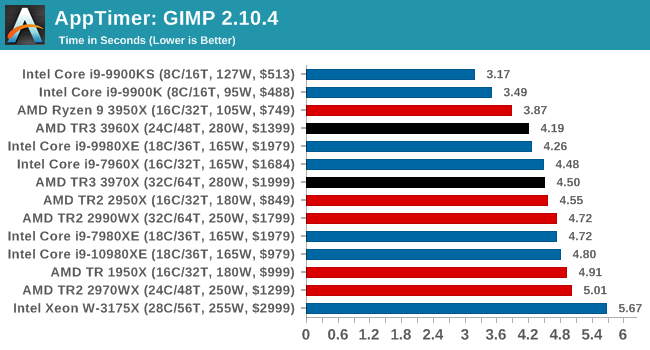
Onto our single threaded tests, and the mainstream hardware with high single thread frequencies wins here, but the 3960X is leading the rest of the pack. Intel's 28-core part here sits last, behind even the 1950X.
3D Particle Movement v2.1: Brownian Motion
Our 3DPM test is a custom built benchmark designed to simulate six different particle movement algorithms of points in a 3D space. The algorithms were developed as part of my PhD., and while ultimately perform best on a GPU, provide a good idea on how instruction streams are interpreted by different microarchitectures.
A key part of the algorithms is the random number generation – we use relatively fast generation which ends up implementing dependency chains in the code. The upgrade over the naïve first version of this code solved for false sharing in the caches, a major bottleneck. We are also looking at AVX2 and AVX512 versions of this benchmark for future reviews.
For this test, we run a stock particle set over the six algorithms for 20 seconds apiece, with 10 second pauses, and report the total rate of particle movement, in millions of operations (movements) per second. We have a non-AVX version and an AVX version, with the latter implementing AVX512 and AVX2 where possible.
3DPM v2.1 can be downloaded from our server: 3DPMv2.1.rar (13.0 MB)
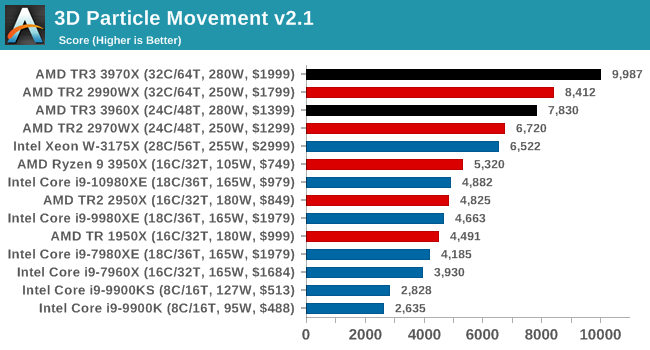
With non-AVX, AMD's floating point units put on a great performance.

This is a workload that can be AVX512 accelerated, and this is the main instance where we can see Intel's CPUs having an advantage.
Dolphin 5.0: Console Emulation
One of the popular requested tests in our suite is to do with console emulation. Being able to pick up a game from an older system and run it as expected depends on the overhead of the emulator: it takes a significantly more powerful x86 system to be able to accurately emulate an older non-x86 console, especially if code for that console was made to abuse certain physical bugs in the hardware.
For our test, we use the popular Dolphin emulation software, and run a compute project through it to determine how close to a standard console system our processors can emulate. In this test, a Nintendo Wii would take around 1050 seconds.
The latest version of Dolphin can be downloaded from https://dolphin-emu.org/
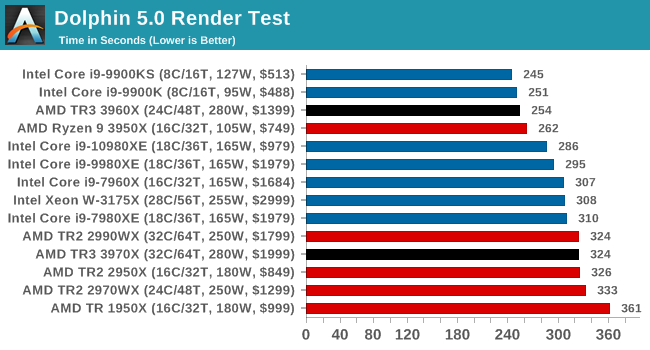
On the single threaded workloads again, and the high frequency mainstream CPUs win here. Interestingly, the 3960X also puts on a really good show, and actually beats our 3950X. Interesting.
DigiCortex 1.20: Sea Slug Brain Simulation
This benchmark was originally designed for simulation and visualization of neuron and synapse activity, as is commonly found in the brain. The software comes with a variety of benchmark modes, and we take the small benchmark which runs a 32k neuron / 1.8B synapse simulation, equivalent to a Sea Slug.
Example of a 2.1B neuron simulation
We report the results as the ability to simulate the data as a fraction of real-time, so anything above a ‘one’ is suitable for real-time work. Out of the two modes, a ‘non-firing’ mode which is DRAM heavy and a ‘firing’ mode which has CPU work, we choose the latter. Despite this, the benchmark is still affected by DRAM speed a fair amount.
DigiCortex can be downloaded from http://www.digicortex.net/
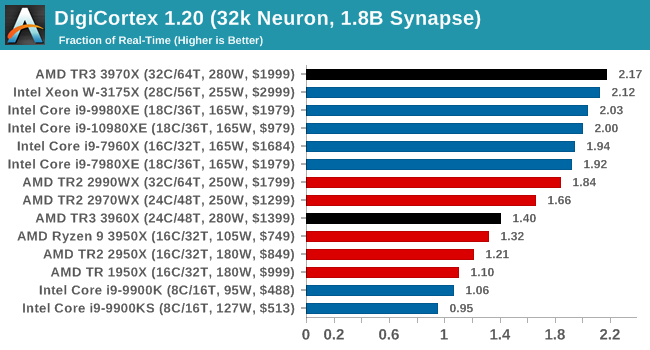
I'm surprised there's that much difference between the 3970X and 3960X here, especially with the 3960X sitting behind the TR2 processors. Might have to re-run this one to double check. But the 3970X puts out a commanding lead.
y-Cruncher v0.7.6: Microarchitecture Optimized Compute
I’ve known about y-Cruncher for a while, as a tool to help compute various mathematical constants, but it wasn’t until I began talking with its developer, Alex Yee, a researcher from NWU and now software optimization developer, that I realized that he has optimized the software like crazy to get the best performance. Naturally, any simulation that can take 20+ days can benefit from a 1% performance increase! Alex started y-cruncher as a high-school project, but it is now at a state where Alex is keeping it up to date to take advantage of the latest instruction sets before they are even made available in hardware.
For our test we run y-cruncher v0.7.6 through all the different optimized variants of the binary, single threaded and multi-threaded, including the AVX-512 optimized binaries. The test is to calculate 250m digits of Pi, and we use the single threaded and multi-threaded versions of this test.
Users can download y-cruncher from Alex’s website: http://www.numberworld.org/y-cruncher/
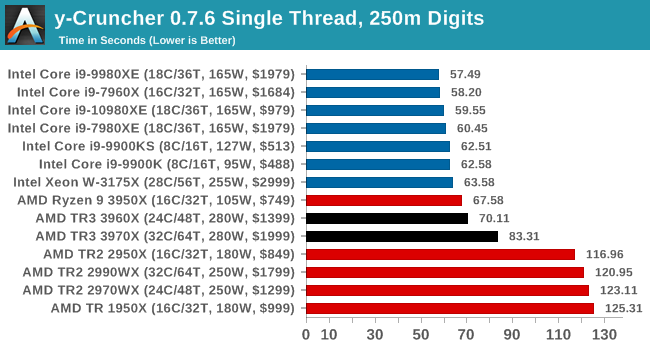
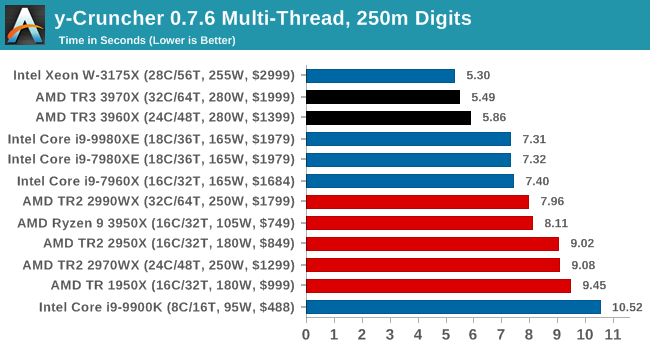
y-Cruncher is also AVX-512 accelerated, however when all the 32 threads come together in MT mode on AVX2, having that many pushes through 18 cores with AVX-512.
Agisoft Photoscan 1.3.3: 2D Image to 3D Model Conversion
One of the ISVs that we have worked with for a number of years is Agisoft, who develop software called PhotoScan that transforms a number of 2D images into a 3D model. This is an important tool in model development and archiving, and relies on a number of single threaded and multi-threaded algorithms to go from one side of the computation to the other.
In our test, we take v1.3.3 of the software with a good sized data set of 84 x 18 megapixel photos and push it through a reasonably fast variant of the algorithms, but is still more stringent than our 2017 test. We report the total time to complete the process.
Agisoft’s Photoscan website can be found here: http://www.agisoft.com/

New records for Photoscan as well.












245 Comments
View All Comments
Slash3 - Tuesday, November 26, 2019 - link
AnandTech frustratingly doesn't seem to ever list their memory subtimings, but as they test at "JEDEC" standard, it may be as loose as 2933 CL19-19-19 vs your 2933 CL14. This could easily account for the difference in benchmark results.alufan - Monday, November 25, 2019 - link
So Thread ripper is here, I will never have a use for this chip but I want one...just because, probably the single biggest uplift in CPU performance for a great many years.Still 10 intel featuring articles on the main page vs 4 featuring AMD though, shame really and it would have been nice for you to have a proper dig at intel for its pathetic attempt to skew CPU bench results by moving the embargo forward, try taking a tip off linus man he told it like it was as have many others.
Grobert783 - Monday, November 25, 2019 - link
So many cores and yet no one cares PLUS we all know AMD sucks. Thank youyeeeeman - Monday, November 25, 2019 - link
LolXyler94 - Monday, November 25, 2019 - link
Ah yes, the infamous "Nobody cares" argument of a fanboy.And yet you cares enough to click the article, go to the comment section, and write this comment. I won't comment about your other comment though, clearly you didn't RTFA
darwi - Monday, November 25, 2019 - link
With so much cores Anandtech should consider virtualization benchmark/uses casesthere is some good automated Lab Scripts available.
On Windows Nested Virtualization is still not enabled on AMD Processor.
-> still not announced for Windows 20H1, perhaps for 2OH2 since major overhaul for Azure is underway.
Ryzen Master is still incompatible with VBS (Virtualization based Security).
This situation prevent to test some features in Windows VM :
- With more and more feature relying on virtualization (WSL, Security, workload isolation, ...)
- For advanced scenarios (Labs for testing infrastructure deployment, ESXi, hyper-v, compiler, etc...)
By ignoring the 1k segment AMD could overplay their advantages :
- the cpu is only a part of the package (you have to add a beefy psu and cooling system and a decent amount
of RAM) if you want to make a meaningfull use of such platform.
- the moherboad price take a major rise (Apple accessories manufacturer syndrom ?) - without high ends feature regarding connectivity
where are the multi-gig network and Thunderbolt ports ?, but RGB pins are plenty ...
- forcing the early TR adopters to a 2k-2,5k investment to jump to the TR3+ architecture (if cooler and RAM, PSU remain the same)
and chipset reset could do some damage too.
And finally the 10980XE (with more PCI 3 lanes, and more memory) will not be the best but enough and more affordable.
I'm a an owner of TR 1950X.
Questions :
> Nested Virtualization will eventually comming to AMD ? (for a future interview with AMD CEO/CTO)
> Air Cooling is it still suitable for TR3 ?
And thanx to Anandtech for those reviews and the worth of drilling down into details.
That's my 2cents.
Irata - Monday, November 25, 2019 - link
Wait, what ? The 10980XE has more PCIe lanes than TR3?And the rest...is pot legal where you live?
darwi - Monday, November 25, 2019 - link
I was comparing with the nearest AMD offrer to the 10908XE v: The Ryzen 3950X.Furthermore the PCI4 cards are very few for the moment.
May be there is some room for a TR3 3950X like the TR 1920 in his time.
The 1K is for 1K$.
lobz - Tuesday, November 26, 2019 - link
I usually don't do drugs but I'll have some from what you're having...Xyler94 - Monday, November 25, 2019 - link
In what world is 60 PCIe 4.0 lanes less than 48 PCIe 3.0 lanes?You do know... that PCIe 4 is backwards compatible, so Threadripper has effectively 60 lanes of PCIe 3, right? I don't know about you... but 60 is more than 48...